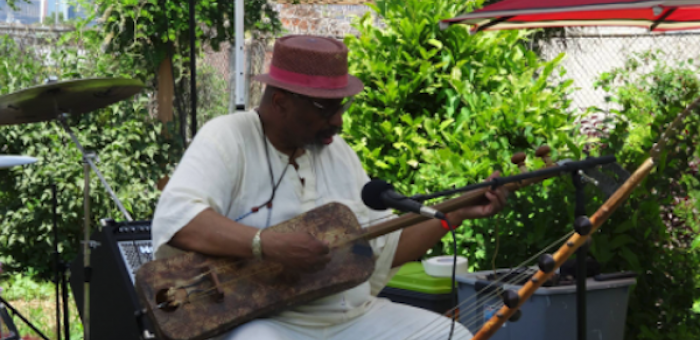Oct 28, 2025 10:47 AM
In Memoriam: Jack DeJohnette, 1942–2025
Jack DeJohnette, a bold and resourceful drummer and NEA Jazz Master who forged a unique vocabulary on the kit over his…

William Parker performs at the Red Hook Jazz Festival in Brooklyn on June 11.
(Photo: James Keepnews)Other New York festivals, in more accessible locations and with much bigger budgets, enjoy way higher profiles, but the down-home Red Hook Jazz Festival has happily survived its decade of existence, taking place in the small Urban Meadow Community Garden. This is on the edge of Red Hook, in Brooklyn, virtually at the waterfront, with huge shipyard loading gantries looming in the background.
It’s an oasis of Brooklyn calm, set up with a makeshift stage, fragile canopies and a select range of $1 pizza slices, melon, lemonade and cookies as its fare of choice. There’s no bar, and an emphatic family friendliness, with many of the attendees seemingly arriving from the locale.
The music is another matter, as many of its acts are heading further out into the realms of jazz exploration than the calm setting might promise. The festival has a typical Brooklyn sense of adventure. Each year, it’s divided between two consecutive Sundays, the first being June 11 on this occasion.
The organizers are Mike Golub and James Keepnews, although they are supported by a team of sympathetic neighborhood helpers. Customarily, five acts will play throughout the afternoon, with no particularly strict timetable, besides the expectation that each combo will appear approximately on the hour.
Fairly promptly, at 1 p.m., the program started strongly with a duo of Cooper-Moore and William Parker, avoiding their core tools, and concentrating on some alternative instruments. Cooper-Moore used a simple cymbal and a frame drum, laid flat, with a smaller drum pressed with varying force and angles against its skin. Parker played sintir, the Moroccan lute used by Gnawa musicians, his chosen conduit for walking basslines. Cooper-Moore trilled on small wooden flute, with this elemental sparseness being perfectly suited to the sun-scorched park environment.
He used twinned sticks on the cymbal, whilst Parker switched to ghaita, the Moroccan double-reed flute. The set took on a pronounced north African character, rather than the jazz-descended free improvisation that audiences might normally expect from this pair. Cooper-Moore built up a booming, resonant weight, while Parker produced a ritualistic bleating. Next, he picked up an instrument that looked like a doson n’goni rather than a kora, an instrument which Don Cherry always used to pack in his tour bag.
Meanwhile, Cooper-Moore clamped down on an extended jaw harp, a long instrument that resonated in a manner suggesting the folk music of Vietnam or Laos. This piece had a tentative beginning, and was so restrained that it seeped into the general garden environment. That’s the way this set was designed, almost ambient in nature.
Drummer and composer Richi Debonis led his five-piece Nowtet through a set of sleek, modernistic, hard-lined jazz, even though his latest batch of work is supposedly based around the repertoire of Led Zeppelin.
Initially, the audience might have thought that Debonis was joking when he started name-checking various Page and Plant tunes (including “Going To California”), so removed were the songs from what we were hearing in our mind’s ear. It was only during the more obvious “Kashmir” that the Zeppelin theme was emphatically confirmed.
Allegedly, the Nowtet also played a Burt Bacharach number, but the players had become so uncaged that, again, it was hard to tell whether Debonis was being serious. Josh Evans offered a peppery trumpet solo, emitting a shocking waft of night-time club sound out in the dazzling daylight. The horns jostled with a loosely executed free theme, a deliberate move, matching the honking and gruffness of the surrounding ambiance. Tenor saxophonist Abraham Burton exuded musical fluidity, his solos operating at a cooler level than those of Evans in an expert reconfiguring of “Kashmir”.
Soprano saxophonist Jane Ira Bloom continued the angular invention, flanked by bassist Cameron Brown and drummer Alison Miller. Her signature technique of sweeping her horn around in circles, markedly affecting its sound, was a central part of her performance. Spatial sensitivity is at the core of Bloom’s compositions. Her solos gave a wriggling chase, as bass and drums adopted the roles of suspension and buoyancy, Bloom constantly in motion, aloft and beyond capture.
“Jazz Lives In Brooklyn” proclaimed the festival banner. Of course it does, particularly on the edge of this waterfront. DB
(Sadly, the second day of the festival (June 18) has been postponed until September, so it’s not yet certain whether the advertised line-up will remain in place.)

Jack DeJohnette boasted a musical resume that was as long as it was fearsome.
Oct 28, 2025 10:47 AM
Jack DeJohnette, a bold and resourceful drummer and NEA Jazz Master who forged a unique vocabulary on the kit over his…

D’Angelo achieved commercial and critical success experimenting with a fusion of jazz, funk, soul, R&B and hip-hop.
Oct 14, 2025 1:47 PM
D’Angelo, a Grammy-winning R&B and neo-soul singer, guitarist and pianist who exerted a profound influence on 21st…

Kandace Springs channeled Shirley Horn’s deliberate phrasing and sublime self-accompaniment during her set at this year’s Pittsburgh International Jazz Festival.
Sep 30, 2025 12:28 PM
Janis Burley, the Pittsburgh International Jazz Festival’s founder and artistic director, did not, as might be…

Jim McNeely’s singular body of work had a profound and lasting influence on many of today’s top jazz composers in the U.S. and in Europe.
Oct 7, 2025 3:40 PM
Pianist Jim McNeely, one of the most distinguished large ensemble jazz composers of his generation, died Sept. 26 at…

Drummond was cherished by generations of mainstream jazz listeners and bandleaders for his authoritative tonal presence, a defining quality of his style most apparent when he played his instrument unamplified.
Nov 4, 2025 11:39 AM
Ray Drummond, a first-call bassist who appeared on hundreds of albums as a sideman for some of the top names in jazz…